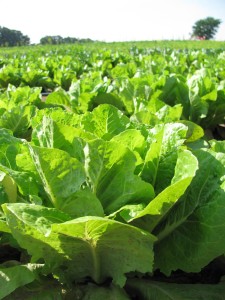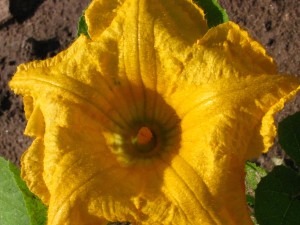This Week on the Farm 6/30
We would like to give a big shout out to Matt, James, Hillary, and Zack for coming out this past Saturday for our first volunteer day! With all of their hard work we finished weeding in the peppers and eggplant! The first weeding is the most critical, so thanks to all of their hard work you will have peppers and eggplants in your boxes later this summer.
It looks like we have survived the torrential downpours of the last week. The forecast looks like there is very little chance of rain for the next ten days (less than 30% each day). Hopefully this will give the fields time to dry out so we can get in with the tractor and start cultivating. But after last year, I have a very hard time trusting the weather forecast.
In addition to all of the cultivation in our near future, we also have more planting to do. There are a few more late summer crops like beans and sweet corn that are now slightly behind schedule and some fall crops like cabbage, broccoli, kohlrabis, and beets that need to get in the ground. Thankfully as soon as the soil can be worked we can sock all of those in with our seeders pretty easily.
 This morning we went out and did a thorough survey of the damage from all of the rain from last week. We are definitely going to have to put in a grass/cover cropped waterway next year. The most damage is not from washout, although there is some damage from that, but mostly from plant roots being denied oxygen from so much rain. Even with our sandy soils, the soil was completely saturated. All of the pores in the soil were filled with water, leaving no room for oxygen. Without oxygen in the soil, the plant roots are in anaerobic conditions. When this happens, the mechanisms by which the plants are able to pull nutrients from the soil are either slowed way down or stopped completely, and the plants slowly starve to death. Thankfully it looks like there will be dry weather ahead, so the damage shouldn’t be severe.
This morning we went out and did a thorough survey of the damage from all of the rain from last week. We are definitely going to have to put in a grass/cover cropped waterway next year. The most damage is not from washout, although there is some damage from that, but mostly from plant roots being denied oxygen from so much rain. Even with our sandy soils, the soil was completely saturated. All of the pores in the soil were filled with water, leaving no room for oxygen. Without oxygen in the soil, the plant roots are in anaerobic conditions. When this happens, the mechanisms by which the plants are able to pull nutrients from the soil are either slowed way down or stopped completely, and the plants slowly starve to death. Thankfully it looks like there will be dry weather ahead, so the damage shouldn’t be severe.
In many places it may have changed the timing of the crop, so that now instead of having the whole planting ready for harvest at one time, sections that were in lower ground will be delayed by a week or two. This may in the long run work to our advantage by spreading the harvest out, but we will have to see.
 On our survey we were able to note some changes in the way things should be planted for next year. For example, the sugar snap peas were planted using a two row John Deere planter. Tyler and I walked alongside (or, more accurately, jogged) and tried to meter the seeds so that they wouldn’t be planted too heavily. In retrospect, we should have just let the planter plant them at the normal rate. For the snow peas, metering worked like a charm, but the sugar snaps are spotty in some areas and planting the seeds more densely will help solve that problem.
On our survey we were able to note some changes in the way things should be planted for next year. For example, the sugar snap peas were planted using a two row John Deere planter. Tyler and I walked alongside (or, more accurately, jogged) and tried to meter the seeds so that they wouldn’t be planted too heavily. In retrospect, we should have just let the planter plant them at the normal rate. For the snow peas, metering worked like a charm, but the sugar snaps are spotty in some areas and planting the seeds more densely will help solve that problem.
Another change we want to make is to plant kale in plugs and transplant the plugs instead of direct seeding the seeds in the spring. The plantings will be more even and hopefully farther along at this point in the season if we transplant them. We made this change with collards this year, and there is a big improvement in plant uniformity.
 After weather like we have had the past couple of weeks, these field inspections can be demoralizing, but both Tyler and I were very happy with how everything looks. Yes there is damage, yes there are things that need to get changed for next year, but overall everything looks really good, weedy, but really good. And in reality, farming is always a battle between the farmer and weeds, so nothing surprising there!
After weather like we have had the past couple of weeks, these field inspections can be demoralizing, but both Tyler and I were very happy with how everything looks. Yes there is damage, yes there are things that need to get changed for next year, but overall everything looks really good, weedy, but really good. And in reality, farming is always a battle between the farmer and weeds, so nothing surprising there!
